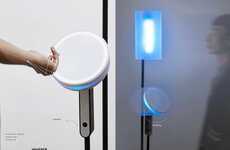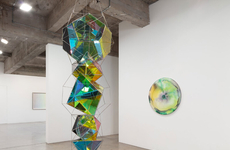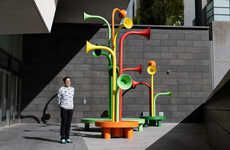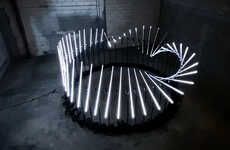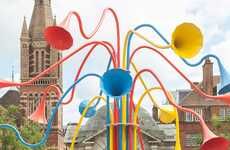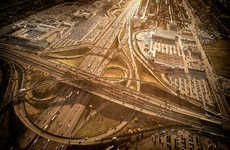
The 'Murmur' Sound Installation Art Visually Depicts Whispers
Laura McQuarrie — June 11, 2013 — Tech
References: creativeapplications.net & gizmodo
'Murmur' is a piece of sound installation art created by a group of designers from Chevalvert, 2Roqs, Polygraphik and Splank. Visitors to the "eco room" can speak into a device that transforms sounds into LED-projected visuals onto a wall using tehchnology like 'Raspberry Pi' and 'openFrameworks.'
The experience mimics the transmission of sound waves through space, having them dramatically "hit" the wall in a display of lights. Depending on the sounds it detects, 'Murmur' will show different visuals like circles, dots and spiderwebs. This installation is one that bridges the gap between the sensory and visual experience of sound, creating the opportunity for people to share their thoughts and see them simultaneously projected onto a physical space.
The experience mimics the transmission of sound waves through space, having them dramatically "hit" the wall in a display of lights. Depending on the sounds it detects, 'Murmur' will show different visuals like circles, dots and spiderwebs. This installation is one that bridges the gap between the sensory and visual experience of sound, creating the opportunity for people to share their thoughts and see them simultaneously projected onto a physical space.
Trend Themes
1. Audio-visual Integration - The 'Murmur' sound installation demonstrates the trend of integrating audio and visual technology to create immersive experiences.
2. Interactive Art Installations - The 'Murmur' installation showcases the trend of interactive art experiences, allowing visitors to actively participate and engage with the artwork.
3. Synesthesia-inspired Design - The 'Murmur' sound installation exemplifies the trend of designing experiences that stimulate multiple senses, blurring the boundaries between sound and visual perception.
Industry Implications
1. Art and Design - The art and design industry can explore creating more interactive installations that combine sound and visuals, inviting audience participation.
2. Entertainment - The entertainment industry can incorporate audio-visual integration in live performances and events, enhancing the sensory experience for the audience.
3. Technology - The technology industry can develop innovative audio-visual integration solutions that enable the creation of immersive experiences in various domains, such as gaming and virtual reality.
1.6
Score
Popularity
Activity
Freshness


